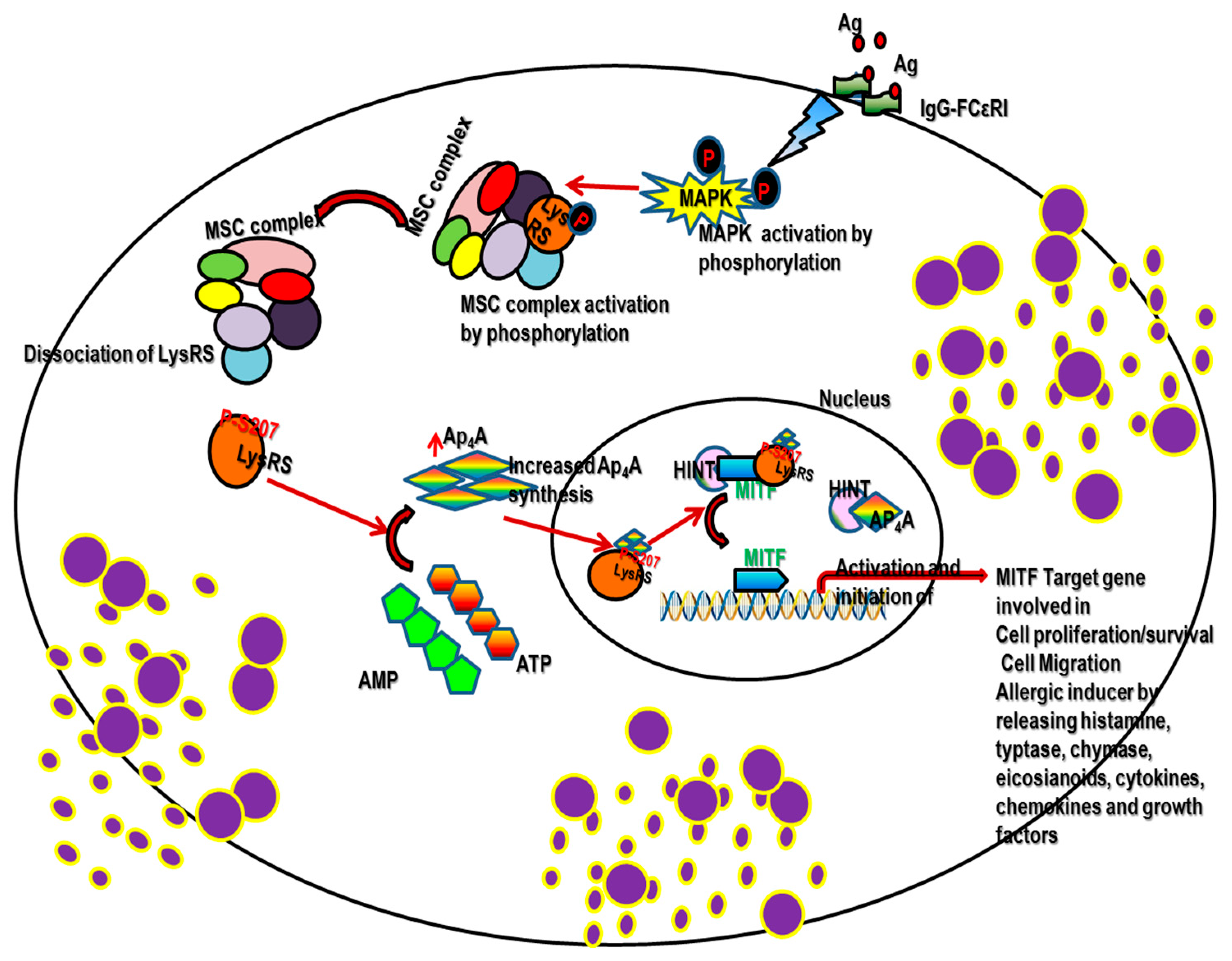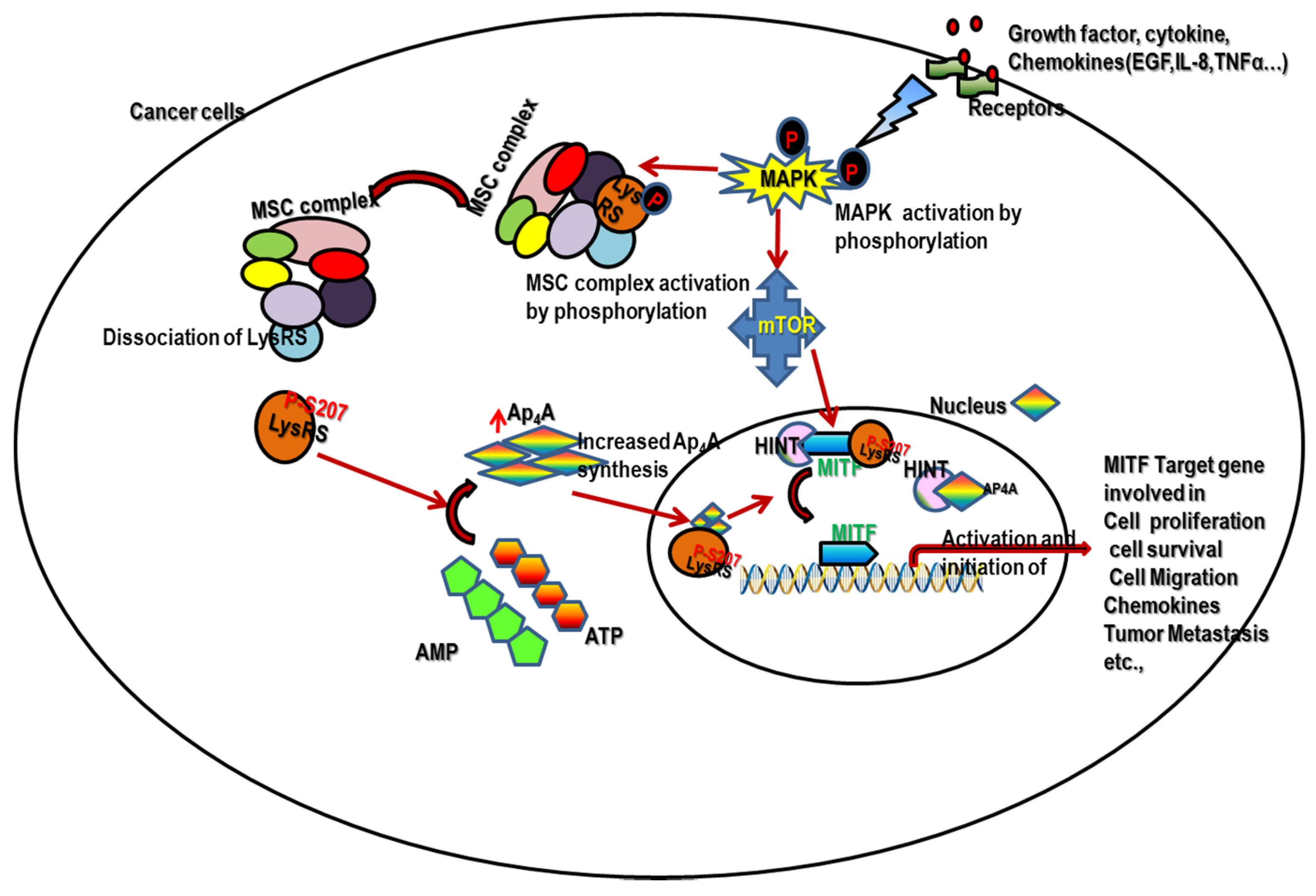The pLysRS-Ap4A Pathway in Mast Cells Regulates the Switch from Host Defense to a Pathological State
Abstract
1. Mast Cells (MCs) and Their Activation Mechanisms
2. The pLysRS Signaling Pathway in IgE-FcεRI Activated Mast Cells (MCs)
3. pLysRS Transcriptional Regulation of MITF, USF2 via the Ap4A–HINT Pathway
4. Role of pLysRS-Ap4A Mediated Signaling under Pathological Conditions
5. Autoimmune Disease
6. Tumor Microenvironment
7. Conclusions
Author Contributions
Funding
Institutional Review Board Statement
Informed Consent Statement
Data Availability Statement
Acknowledgments
Conflicts of Interest
Abbreviations
| aaRSs | Aminoacyl-tRNA synthetase |
| Ap3A or Ap5A | Diadenosine tetraphosphate or diadenosine pentaphosphate |
| Ap4A | Diadenosine tetraphosphate |
| B cell | B cell lymphocytes |
| CCL3 | Chemokine CC motif ligand 3, |
| cGAMP | Cyclic GMP–AMP |
| cGAS | Cyclic GMP–AMP(cGAMP) synthetase |
| c-Kit | CD117, also called KIT or c-Kit receptor |
| c-Met | Mesenchymal–epithelial transition factor |
| CXCL8 | Chemokine CXC motif ligand 8 |
| DCs | Dendritic cells |
| EGFR | Epidermal growth factor receptor |
| ERK | Extracellular signal-related kinase |
| HINT1 | Histidine triad nucleotide-binding protein 1 |
| IFN-α, β | Interferon alpha, beta |
| IFNγ | Interferon gamma γ |
| IgE | Immunoglobulin E |
| IgE-FcεR | Immunoglobulin E FC epsilon RI |
| IgG-FcγRI | Immunoglobulin G FC gamma RI |
| IL-1 | Interleukin-1 |
| IL-1β | Interleukin-1 beta |
| IL-6 | Interleukin-6 |
| ITAM | Immunoreceptor tyrosine-based activation motifs |
| JNK | Janus kinase |
| Lyn | Lck/Yes novel tyrosine kinase |
| LysRS | Lysine-tRNA synthetase |
| LysRSS207A | Lys phosphorylation at serine 207 serine-to-alanine mutation |
| LysRSS207D | Lys phosphorylation at serine 207 serine-to-aspartate mutation |
| MAPK | Mitogen-activated protein kinase |
| MCs | Mast cells |
| MDSCs | Myeloid-derived suppressor cell |
| MITF | Microphthalmia-associated transcription factor |
| MSC | Multisynthetase complex |
| NF-κB | Nuclear factor kappa B |
| p38 MAP kinase | p38 mitogen-activated protein kinase |
| PAR | Protease-activated receptor |
| PI3Ks | Phosphoinositide 3-kinases |
| PLCγ | Phospholipases Cγ |
| pLysRS | Phosphorylated lysine-tRNA synthetase |
| PRRs | Pattern recognition receptors |
| Rac | Rho family GTPase |
| Ras | Rat sarcoma |
| Rho | Ras homologous protein |
| SLP | SH2-domain-containing leukocyte protein |
| Src | v-src sarcoma (Schmidt-Ruppin A-2) viral oncogene homolog (avian) |
| STING | Stimulator of interferon genes |
| SyK | Spleen tyrosine kinase |
| T cell | Thymus lymphocytes |
| TAMs | Tumor-associated macrophages |
| TNF | Tumor necrosis factor |
| USF2 | Upstream transcription factor 2 |
References
- Urb, M.; Sheppard, D.C. The Role of Mast Cells in the Defence against Pathogens. PLoS Pathog. 2012, 8, e1002619. [Google Scholar] [CrossRef]
- Woolhiser, M.; Brockow, K.; Metcalfe, D.D. Activation of human mast cells by aggregated IgG through FcγRI: Additive effects of C3a. Clin. Immunol. 2004, 110, 172–180. [Google Scholar] [CrossRef] [PubMed]
- Supajatura, V.; Ushio, H.; Nakao, A.; Akira, S.; Okumura, K.; Ra, C.; Ogawa, H. Differential responses of mast cell Toll-like receptors 2 and 4 in allergy and innate immunity. J. Clin. Investig. 2002, 109, 1351–1359. [Google Scholar] [CrossRef] [PubMed]
- Witczak, P.; Brzezińska-Błaszczyk, E.; Agier, J. The Response of Tissue Mast Cells to TLR3 Ligand Poly(I:C) Treatment. J. Immunol. Res. 2020, 2020, 1–13. [Google Scholar] [CrossRef] [PubMed]
- Xu, Y.; Chen, G. Mast Cell and Autoimmune Diseases. Mediat. Inflamm. 2015, 2015, 1–8. [Google Scholar] [CrossRef]
- Brenner, T.; Soffer, V.; Shalit, M.; Levi-Schaffer, F. Mast cells in experimental allergic encephalomyelitis: Characterization, distribution in the CNS and in vitro activation by myelin basic protein and neuropeptides. J. Neurol. Sci. 1994, 122, 210–213. [Google Scholar] [CrossRef]
- Min, H.K.; Kim, K.-W.; Lee, S.-H.; Kim, H.-R. Roles of mast cells in rheumatoid arthritis. Korean J. Intern. Med. 2020, 35, 12–24. [Google Scholar] [CrossRef] [PubMed]
- Constantinescu, C.S.; Farooqi, N.; O’Brien, K.; Gran, B. Experimental autoimmune encephalomyelitis (EAE) as a model for multiple sclerosis (MS). Br. J. Pharmacol. 2011, 164, 1079–1106. [Google Scholar] [CrossRef]
- Ribatti, D.; Crivellato, E. Mast cells, angiogenesis, and tumour growth. Biochim. Biophys. Acta (BBA) Mol. Basis Dis. 2012, 1822, 2–8. [Google Scholar] [CrossRef]
- Hermans, M.A.W.; Van Lennep, J.E.R.; Van Daele, P.L.A.; Bot, I. Mast Cells in Cardiovascular Disease: From Bench to Bedside. Int. J. Mol. Sci. 2019, 20, 3395. [Google Scholar] [CrossRef] [PubMed]
- Malak, A.; Mohamed, M.; Hassan, A. Type I Hypersensitivity Reaction; StatPearls Publishing, Treasure Island (FL): Hong Kong, China, 4 May 2021. Available online: https://www.ncbi.nlm.nih.gov/books/NBK560561/ (accessed on 25 May 2021).
- Blank, U.; Ra, C.; Miller, L.; White, K.; Metzger, H.; Kinet, J.-P. Complete structure and expression in transfected cells of high affinity IgE receptor. Nat. Cell Biol. 1989, 337, 187–189. [Google Scholar] [CrossRef]
- Mócsai, A.; Ruland, J.; Tybulewicz, V.L.J. The SYK tyrosine kinase: A crucial player in diverse biological functions. Nat. Rev. Immunol. 2010, 10, 387–402. [Google Scholar] [CrossRef] [PubMed]
- Siraganian, R.P.; De Castro, R.O.; Barbu, E.A.; Zhang, J. Mast cell signaling: The role of protein tyrosine kinase Syk, its activation and screening methods for new pathway participants. FEBS Lett. 2010, 584, 4933–4940. [Google Scholar] [CrossRef] [PubMed]
- Yannay-Cohen, N.; Carmi-Levy, I.; Kay, G.; Yang, C.M.; Han, J.M.; Kemeny, D.M.; Kim, S.; Nechushtan, H.; Razin, E. LysRS Serves as a Key Signaling Molecule in the Immune Response by Regulating Gene Expression. Mol. Cell 2009, 34, 603–611. [Google Scholar] [CrossRef] [PubMed]
- Lee, Y.N.; Razin, E. Nonconventional Involvement of LysRS in the Molecular Mechanism of USF2 Transcriptional Activity in FcεRI-Activated Mast Cells. Mol. Cell. Biol. 2005, 25, 8904–8912. [Google Scholar] [CrossRef]
- Lee, Y.-N.; Nechushtan, H.; Figov, N.; Razin, E. The Function of Lysyl-tRNA Synthetase and Ap4A as Signaling Regulators of MITF Activity in FcϵRI-Activated Mast Cells. Immunity 2004, 20, 145–151. [Google Scholar] [CrossRef]
- Khan, K.; Baleanu-Gogonea, C.; Willard, B.; Gogonea, V.; Fox, P.L. 3-Dimensional architecture of the human multi-tRNA synthetase complex. Nucleic Acids Res. 2020, 48, 8740–8754. [Google Scholar] [CrossRef] [PubMed]
- Brevet, A.; Plateau, P.; Cirakoğlu, B.; Pailliez, J.P.; Blanquet, S. Zinc-dependent synthesis of 5’,5’-diadenosine tetraphosphate by sheep liver lysyl- and phenylalanyl-tRNA synthetases. J. Biol. Chem. 1982, 257, 14613–14615. [Google Scholar] [CrossRef]
- Hilderman, R.H.; Ortwerth, B.J. A preferential role for lysyl-tRNA4 in the synthesis of diadenosine 5’,5’’’-P1P4-tetraphosphate by an arginyl-tRNA synthetase-lysyl-tRNA synthetase complex from rat liver. Biochemistry 1987, 26, 1586–1591. [Google Scholar] [CrossRef]
- Abraham, S.N.; John, A.S. Mast cell-orchestrated immunity to pathogens. Nat. Rev. Immunol. 2010, 10, 440–452. [Google Scholar] [CrossRef]
- Akin, C. Mast cell activation syndromes. J. Allergy Clin. Immunol. 2017, 140, 349–355. [Google Scholar] [CrossRef]
- Rozniecki, J.J.; Hauser, S.L.; Stein, M.; Lincoln, R.; Theoharides, T.C. Elevated mast cell tryptase in cerebrospinal fluid of multiple sclerosis patients. Ann. Neurol. 1995, 37, 63–66. [Google Scholar] [CrossRef]
- Malamud, V.; Vaaknin, A.; Abramsky, O.; Mor, M.; Burgess, L.E.; Ben-Yehudah, A.; Lorberboum-Galski, H. Tryptase activates peripheral blood mononuclear cells causing the synthesis and release of TNF-α, IL-6 and IL-1β: Possible relevance to multiple sclerosis. J. Neuroimmunol. 2003, 138, 115–122. [Google Scholar] [CrossRef]
- Kumar, V. A STING to inflammation and autoimmunity. J. Leukoc. Biol. 2019, 106, 171–185. [Google Scholar] [CrossRef] [PubMed]
- Guerra, J.; Valadao, A.-L.; Vlachakis, D.; Polak, K.; Vila, I.K.; Taffoni, C.; Prabakaran, T.; Marriott, A.S.; Kaczmarek, R.; Houel, A.; et al. Lysyl-tRNA synthetase produces diadenosine tetraphosphate to curb STING-dependent inflammation. Sci. Adv. 2020, 6, eaax3333. [Google Scholar] [CrossRef] [PubMed]
- Kim, S.; You, S.; Hwang, D. Aminoacyl-tRNA synthetases and tumorigenesis: More than housekeeping. Nat. Rev. Cancer 2011, 11, 708–718. [Google Scholar] [CrossRef]
- Young, H.J.; Lee, J.W.; Kim, S. Function of membranous lysyl-tRNA synthetase and its implication for tumorigenesis. Biochim. Biophys. Acta (BBA) Proteins Proteom. 2016, 1864, 1707–1713. [Google Scholar] [CrossRef] [PubMed]
- Carmi-Levy, I.; Yannay-Cohen, N.; Kay, G.; Razin, E.; Nechushtan, H. Diadenosine Tetraphosphate Hydrolase Is Part of the Transcriptional Regulation Network in Immunologically Activated Mast Cells. Mol. Cell. Biol. 2008, 28, 5777–5784. [Google Scholar] [CrossRef]
- Carmi-Levy, I.; Motzik, A.; Ofir-Birin, Y.; Yagil, Z.; Yang, C.M.; Kemeny, D.M.; Han, J.M.; Kim, S.; Kay, G.; Nechushtan, H.; et al. Importin Beta Plays an Essential Role in the Regulation of the LysRS-Ap4A Pathway in Immunologically Activated Mast Cells. Mol. Cell. Biol. 2011, 31, 2111–2121. [Google Scholar] [CrossRef]
- Huete, F.; Guzmán-Aránguez, A.; Ortín, J.; Hoyle, C.H.V.; Pintor, J. Effects of diadenosine tetraphosphate on FGF9-induced chloride flux changes in achondroplastic chondrocytes. Purinergic Signal. 2011, 7, 243–249. [Google Scholar] [CrossRef][Green Version]
- Tshori, S.; Razin, E.; Nechushtan, H. Amino-Acyl tRNA Synthetases Generate Dinucleotide Polyphosphates as Second Messengers: Functional Implications. Aminoacyl-tRNA Synth. Biol. Med. 2014, 344, 189–206. [Google Scholar] [CrossRef]
- Genovese, G.; Ghosh, P.; Li, H.; Rettino, A.; Sioletic, S.; Cittadini, A.; Sgambato, A. The tumor suppressor HINT1 regulates MITF and β-catenin transcriptional activity in melanoma cells. Cell Cycle 2012, 11, 2206–2215. [Google Scholar] [CrossRef] [PubMed]
- Yu, J.; Liu, Z.; Liang, Y.; Luo, F.; Zhang, J.; Tian, C.; Motzik, A.; Zheng, M.; Kang, J.; Zhong, G.; et al. Second messenger Ap4A polymerizes target protein HINT1 to transduce signals in FcεRI-activated mast cells. Nat. Commun. 2019, 10, 1–12. [Google Scholar] [CrossRef]
- Boulos, S.; Park, M.C.; Zeibak, M.; Foo, S.Y.; Jeon, Y.K.; Kim, Y.T.; Motzik, A.; Tshori, S.; Hamburger, T.; Kim, S.; et al. Cor-rection: Serine 207 phosphorylated lysyl-tRNA synthetase predicts disease-free survival of non-small-cell lung carcinoma. Oncotarget 2017, 8, 36250. [Google Scholar] [CrossRef] [PubMed]
- Nam, S.H.; Kim, D.; Lee, D.; Lee, H.-M.; Song, D.-G.; Jung, J.W.; Kim, J.E.; Kim, H.-J.; Kwon, N.H.; Jo, E.-K.; et al. Lysyl-tRNA synthetase–expressing colon spheroids induce M2 macrophage polarization to promote metastasis. J. Clin. Investig. 2018, 128, 5034–5055. [Google Scholar] [CrossRef] [PubMed]
- Germain, R.N.; Robey, E.A.; Cahalan, M.D. A Decade of Imaging Cellular Motility and Interaction Dynamics in the Immune System. Science 2012, 336, 1676–1681. [Google Scholar] [CrossRef] [PubMed]
- La Shu, S.; Paruchuru, L.B.; Tay, N.Q.; Chua, Y.L.; Foo, A.S.Y.; Yang, C.M.; Liong, K.H.; Koh, E.G.L.; Lee, A.; Nechushtan, H.; et al. Ap4A Regulates Directional Mobility and Antigen Presentation in Dendritic Cells. Iscience 2019, 16, 524–534. [Google Scholar] [CrossRef]


Publisher’s Note: MDPI stays neutral with regard to jurisdictional claims in published maps and institutional affiliations. |
© 2021 by the authors. Licensee MDPI, Basel, Switzerland. This article is an open access article distributed under the terms and conditions of the Creative Commons Attribution (CC BY) license (https://creativecommons.org/licenses/by/4.0/).
Share and Cite
Govindaraj, S.; Paruchuru, L.B.; Razin, E. The pLysRS-Ap4A Pathway in Mast Cells Regulates the Switch from Host Defense to a Pathological State. Int. J. Mol. Sci. 2021, 22, 5620. https://doi.org/10.3390/ijms22115620
Govindaraj S, Paruchuru LB, Razin E. The pLysRS-Ap4A Pathway in Mast Cells Regulates the Switch from Host Defense to a Pathological State. International Journal of Molecular Sciences. 2021; 22(11):5620. https://doi.org/10.3390/ijms22115620
Chicago/Turabian StyleGovindaraj, Sharmila, Lakshmi Bhargavi Paruchuru, and Ehud Razin. 2021. "The pLysRS-Ap4A Pathway in Mast Cells Regulates the Switch from Host Defense to a Pathological State" International Journal of Molecular Sciences 22, no. 11: 5620. https://doi.org/10.3390/ijms22115620
APA StyleGovindaraj, S., Paruchuru, L. B., & Razin, E. (2021). The pLysRS-Ap4A Pathway in Mast Cells Regulates the Switch from Host Defense to a Pathological State. International Journal of Molecular Sciences, 22(11), 5620. https://doi.org/10.3390/ijms22115620






